Art of the Genre: An Interview with Michael Whelan
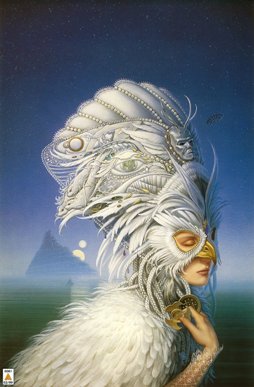
As L.A. does its best to cope with the overcast and chilly mornings of what we call ‘June Gloom’, I find myself drifting in and out of an office catnap, Ryan Harvey’s Writer’s of the Future acceptance speech echoing through the office for the hundredth time. Kandline, one of our aspiring actresses turned receptionists, pokes her head into the office and announces that another package has arrived for me from Chicago.
Now of course this means John O’Neill is again up to no good, our intrepid leader having found yet another way to get me Zeppelin riding for some reason. His note, attached to a rather daunting itinerary, indicates that I’m to head to the Connecticut via the Empire State for an interview with none other than artist Michael Whelan.
Well, if there is one thing that can get me moving out of L.A. in a hurry [other than Ryan’s WotF speech] it’s a chance to swap stories with a Hugo award winning artist. To that end, I packed my things and made the trip to the east coast.
Whelan lives in the pleasant little college town of Danbury Connecticut, but having had some experience in the area, I chose to meet him at Lucia Ristorante in New Milford for a nice lunch, no other place outside NYC having the kind of brilliant lunch fare found there.
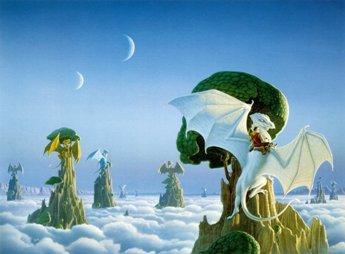
We got a window seat looking out onto Bank Street and I couldn’t resist ordering up some calamari fritti which I know my wife [the vegetarian] would frown upon. Michael was looking nowhere close to his sixty years as a steady regimen of studio work, Chinese-Okinawan Kempo, and world travel keep him looking young and vibrant. It was a pleasant talk, his manner inviting and there was always a distinct sense of provoking intelligence that stirred our conversation during lunch until the topic finally turned to the interview.
For all of you out there in BG land, let me try to introduce a side of Michael Whelan that might not be commonly known.
An Interview With Michael Whelan
Conducted and transcribed by Scott Taylor, May 2011
.
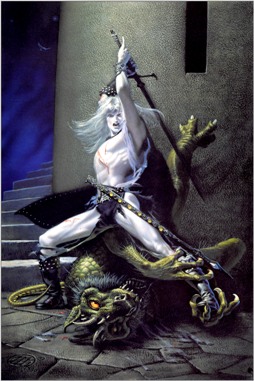
BG: Fifteen years ago [at only 46 years of age] you stopped accepting commissioned works. What brought you to that decision?
MW: HAH! That worked out well, didn’t it? Since making that premature declaration I’ve done many illustrations, but I have been taking fewer commissions. I had been illustrating for more than two decades at that point and thought that it was time to turn to other work. At the same time, I was finding that my gallery work was doing well enough that I could devote my time to my non-illustrative images. It was very liberating to be able to do my own things and not have to follow a manuscript.
Finally, I was looking for a way to reduce stress in my life. After decades of rushing to meet deadlines I thought that getting away from illustration might help me in that regard.
BG: If there is a proverbial ‘top’ of fantasy art, you’ve broken that and transcended to something else completely. Was the metamorphosis to fine art planned or more organic?
MW: Not planned. It arose naturally, I’d say, from feeling, after 25 years or so, that I needed to transcend the format and subject limitations inherent in my illustration work. For the first 20 years of my career, if someone asked me “what I did for myself” art-wise, my answer would be “Illustration is all I want to do.”
BG: Take me through a typical Michael Whelan day in Danbury. Breakfast, morning routine, if you went out for lunch, where would you go, afternoon routine, dinner, and your evening. I mean, people want to know if you’re like us or a robot from the future with mad painting software.
MW: “Typical” days are hard to define. I’m not trying to dodge the question, but to be honest it varies from day to day. There are days when I feel like working til 3am, others when I want to get to it at 7am. Most mornings, however, I get up sometime between 8 and 9, have some coffee and breakfast and go to the studio. I usually break for lunch around 2. I then work til about 5:30 then stop to get some exercise before dinner. We eat later than we used to, sometimes not until 8 or after. After a bit of TV I’m usually back in the studio til midnight. 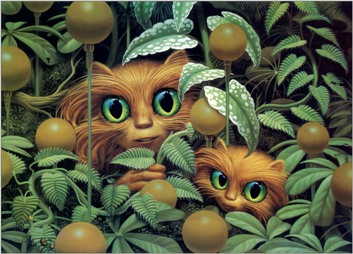
But this changes quite a bit according to events, flashes of inspiration, whatever. If there’s a gorgeous sunset I’ll stop what I’m doing and go photograph it. Sometimes I’ll get an idea in the middle of the night, or right when I wake up, so then I’ll go off to the studio to write notes or do sketches to record the idea.
I fantasize about being more disciplined, living with a set, reliable routine every day, but I’m just not made that way. Much of what I do each day depends on how my work is going. Invariably, when I’m at the final stages of a work I am up with it into the wee hours of the night. I don’t know why, it just feels right. If I am at the edge of a deadline I throw every other consideration to the wind and work night and day on it to try to have it done as soon as possible.
What changes least, I suppose, is my exercise routine. I go to the track at the local high school for about an hour or so every other day. On alternate days I do other exercises. But in any case I try to fit in my minimum number of pushups, situps and leg squats every day, and the stretches I learned when I studied Kempo.
Afternoons are my lowest point of the day, energy-wise. I find if I’m getting sleepy in the afternoon, 50 pushups will wake me up pretty well– plus I don’t have to wait for a kettle to boil. [But I’m human– I often have some tea in the late afternoon anyway.]
I take a camera and a pocket notebook with me everywhere, even when I go to the track. I get a lot of ideas while I’m out and I use the camera to record visual tidbits and impressions, the notepad to write thoughts down. 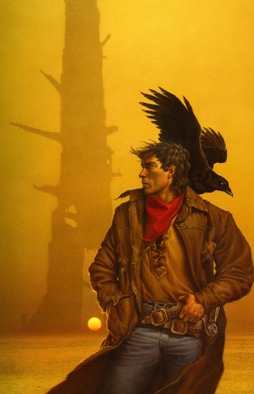
BG: Todd Lockwood once told me that if given an opportunity by the publisher, he’d read the entire book before doing a cover. I’ve heard that you not only read the book, but try reading it twice. Other than the obvious of getting to know the book and characters, what are you looking for in those pages when you decide on a cover?
MW: The first time through I’m looking to grasp what is important in the book, the overall feel and distinguishing facets that make it unique. As I work my way through the manuscript if I notice an idea, scene, or detail that calls to me I’ll make note of it – but often I don’t decide what I am going to focus on until I’m done with the book. So that means I usually have to go through it at least one more time to make note of details that will insure as much accuracy in the portrayal of key elements as possible.
BG: In all your credits, I could only find three paintings done for role-playing games, those being Steve Jackson’s GURPS. I find it hard to believe Jackson was the only gaming company to approach you during your career. It there a reason he won the contract and no one else did?
MW: …and that instance was just the purchase of an already existing image done for a book cover, which Steve Jackson’s company thought might work for a good promo piece. Believe it!
My guess is that most of the companies feel they can get “good enough” artwork from less expensive and more pliable artists. Also, most gaming companies demand work-for-hire contracts, which I will consider only under very rare circumstances.
BG: 16 Hugos… what’s up with that?
MW: Don’t ask me, ask the people who do the voting. It’s not like I go out and campaign for it. I’d rather win than not win, of course, but I’m not interested in winning from uninformed voters either. There’s a lot of talent around.
BG: Do you consider yourself the Academy Award equivalent of John Williams?
MW: You’re joking, right? I appreciate the affection that comes with the awards, but unlike the Oscars, I don’t see any evidence that it translates into heightened success or more income.
BG: Have you ever seen a movie or read a book and thought, ‘I could do that cover’? 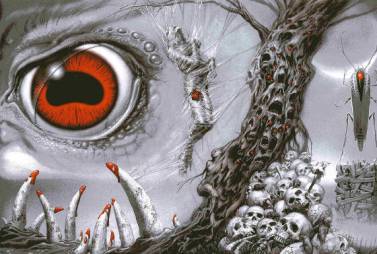
MW: No. But I’ve been to plenty of galleries and museums and thought “My work has more validity than this stuff.”
BG: Our world is an incredible place, most of us only seeing bits and pieces of it if we watch the Travel Channel. Still, I feel like a great deal of your work bridges a gap between otherworld-fantasy and the blending of sights normally unseen but certainly present here on our own planet. Can you comment on this?
MW: Hmm. Joni Mitchell said, “An artist is a person who sees the world in metaphors.” and there’s some truth in that for me. When I’m out doing things with people I sometimes seem to notice things that they don’t see. Some of what I experience comes with cross-connections to ideas or feelings about other things. Occasionally the connection is one I can grasp right away, other times I can feel it but I leave the understanding of why my mind has made the connection for later – I just run with it on faith.
My mother once told me that when I was a toddler and she put me in a playpen I would often just sit there and stare off into space. She said she and my dad would wonder if I was mentally retarded or something. I can’t remember back that far, of course, but if I were to guess I’d say I was probably just collecting impressions, and losing myself in experiencing the moment. It’s a faculty I’ve always valued.
BG: To me, it looks like you’ve done pretty much everything where art is concerned, but I have to wonder if there is a type of art out there you’d still like to try? 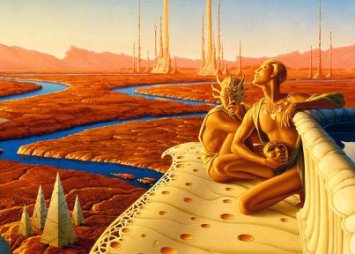
MW: My impression is exactly the opposite of yours. I feel I have hardly done anything and that I’ve barely scratched the surface of things I’d like to do, directions I could throw myself into. If only I had a bevy of clones to get to some of the other stuff I want to do! The main necessity is win a lottery first, or get a MacArthur grant or something, so that money wasn’t an issue and I could devote the time and resources I’d like to other things.
BG: I own a single book dedicated to only one artist, The Art of Michael Whelan [1993]. It sits on my shelf and I refuse to open it because if I do, I’d feel inadequate in all facets of my life. Is it possible your art is too good?
MW: Not a chance. There isn’t a single piece I’ve done that is free of errors or missteps, but what are ya gonna do? You got to move forward.
BG: If you were twenty years old today, would you still go into art or would you choose another profession?
MW: Good question. I don’t know, because if I was 20 today I wouldn’t be who I am…I’d have been exposed to digital media and gaming etc. at a much earlier age, for example. If I could go back to when I was 20, I probably would still do pretty much the same thing, but I would have explored my gallery work sooner perhaps.
BG: Is digital art ‘real’ art?
MW: Real enough to completely change the field of illustration in my lifetime! 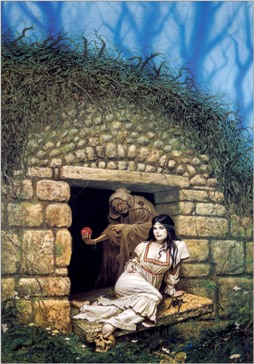
BG: What’s left on your bucket list?
MW: As far as art is concerned, if I have the time and can afford to do it, there is a series of sculptures I’ve been wanting to do since the late 80s. There are several series of paintings I want to get done before I get much older. I’d like to have a show in a Manhattan gallery, receive favorable reviews in well–respected art magazines and the New York Times, be featured in a major art museum…before I’m too old to enjoy the fruits of such success. [Hey, I told you I can dream, right?]
Outside of the art world, I’d like to be a published fiction writer. I have been writing, but I’m not ready yet to try to publish. Maybe in another year or two. I still love electronic music, but there just isn’t enough time for me to compose. It’s extremely frustrating to hear recorded pieces by others that contain elements or qualities I thought of but never acted upon. Boo.
Lastly, there are places I’d like to travel to and things I’d like to experience, but this list is getting too long already!
BG: Dragons or Fuzzies, which is more fun?
MW: I’d say it’s dragons by a nose.
So the interview comes to an end, and perhaps I had more questions than answers when it was all done, but Michael is such a genuine and down to earth guy that I couldn’t take more of his time, I mean he does have a lot left on his plate! I’d like to thank John O’Neill for giving me the ability to do this interview, and of course Michael for humoring me with it. As long as there are artists like him, our world will be a much richer place.
Fantastic interview with a fantastic artist! Whelan is a giant–so cool to have this interview at BG. I love the Joni Mitchell quote: Artists are indeed people who see the world in metaphors.
Whelan rules.
I met Whelan once and it was the only time in my life where I found myself tongue-tied with fanboy awe in the presence of an artist. Usually I can manage to croak out a few semi-coherent remarks and appear to be a moderately rational entity. Not that time.
Whelan is responsible for some of the finest, most iconic, genre art ever, but his cover for Moorcock’s Elric at the End of Time seems to me to be all but perfect.
Thanks, Scott. Great interview.
Any chance of having a word or two with Stephen Hickman?
Fultz: Hey, wanted to say congrats on the book deal, and I enjoyed the twist at the end of your latest BG work. Oh, and were the flowers in the story a hybrid of D&D’s Vampire Roses? How about a Potion of Spider Climb? I was certainly having fun with it.
Anyway, glad you enjoed the interview, Whelan was a fun one to talk to. Metaphors indeed… 🙂
J Hocking: Wouldn’t it be fun to have a Whelan on your own personal book cover? I still contend the book would ‘sell itself’ just from him doing a cover.
As to the interview, you’re very welcome, and the pleasure was all mine. And I guess there’s no rest for the ‘wicked’ as its off to search out Mr. Hickman 😉
Hey, Scott,
Thanks for the kind words, man. Actually the vampiric plants in “The Vintages of Dream” were probably inspired by Howard’s “The Garden of Fear.” When I was a kid I read the Barry Smith/Roy Thomas adaptation of the story in the CONAN THE BARBARIAN comic, and those deadly flora stuck with me. As for the “distillation of behemoth spider-webs” that Thulon uses to climb the tower, they were my first inkling of the kingdom of Ghoth, where giant spiders are worshipped as holy beings and live in symbiosis with the city’s (human?) inhabitants. I explored that idea later in the story “Oblivion Is the Sweetest Wine”–which ironically ran in BG years BEFORE “Vintages” (in 2005). It’s funny how, no matter what order you write your stories in, they rarely get published in the order you write them. Ah, I guess that what story collections are for, eh? 🙂
Fultz: Collections indeed, and I’m sure yours would be an awesome one. I read the preview of Wine on the BG site I think, but now what I have that issue from the awesome back issue sale, I think I shall go and finish it! 😉
Oh, man. Whelan rocks so hard. Thanks for this!
Claire: I’ve heard from Amal that you ‘rock so hard’ 😉
an amazing art and an amazing interview, it’s a luck to work for bg when you can known your idols in literature or art, could be interesting interviews or if not possible dossiers about the art of people like Chris Achilleos, Boris Vallejo, Rowena Merrill, Ken Kelly…?
Francisco: Thanks for the kind words! Oh, and you never know who might be next in the hopper 😉
Scott: Amal stole the phrase from ME!
Or did she?
Dang it. After 4 years of friendship, habits of speech get tangled.
[…] http://www.blackgate.com/2011/06/08/art-of-the-genre-an-interview-with-michael-whelan/ Like Tweet […]